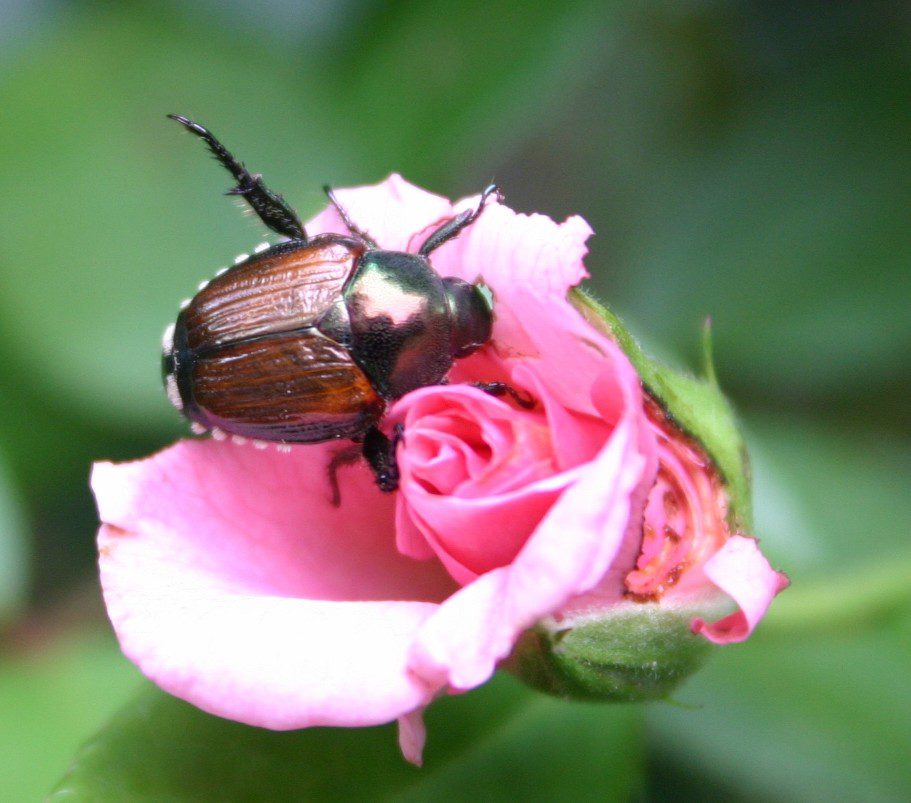Japanese beetles are back! If you’ve noticed skeletonized leaves or clusters of metallic green bugs swarming your plants, you’re not alone. These invasive pests are becoming a recurring issue throughout Mid-Michigan, and the damage they cause can escalate quickly. This year’s surge is especially noticeable, and there’s a reason for it: we saw high grub populations this spring due to last fall’s severe drought. Dry conditions prevented natural soil fungi from controlling the grubs, allowing more to survive the winter. Now, those grubs have emerged as adult beetles, completing a cycle that often repeats itself unless properly managed.
In our recent blog post, we talked about how to spot Japanese beetles and why they’re such a persistent threat. Here’s a deeper dive into what makes them so destructive, and what you can do to protect your landscape.
Why Are Japanese Beetles a Problem?
Japanese beetles may look small, about half an inch long, but they can devastate a landscape. Adult beetles feed on over 300 plant species, including roses, lindens, birches, grapes, and fruit trees. They chew leaf tissue between the veins, leaving a “skeleton” behind, and often gather in large numbers, making the damage even more severe.
Beneath the surface, the problem continues. Japanese beetle larvae, or grubs, live in the soil and feed on grass roots, leading to brown patches and weakened lawns. These grubs are also a favorite food for raccoons and skunks, which may tear up your lawn in search of a meal.
When Do Japanese Beetles Appear?
In Mid-Michigan, adult beetles typically emerge in late June or early July and are active for 4–6 weeks. This short window is when they feed, mate, and lay eggs in the soil. By late summer, those eggs hatch into grubs that will overwinter underground before repeating the cycle next year.
What Can You Do About Them?
As we mentioned in our recent post, early action is key to minimizing beetle damage. Here are some proactive steps you can take:
1. Manual Removal
In the early morning or late evening when beetles are sluggish, knock them off plants into a container of soapy water. This may sound simple, but consistent removal can reduce populations and limit feeding damage.
2. Avoid Beetle Attractants
Japanese beetle traps are widely available, but they often do more harm than good, drawing more beetles into your yard than they actually trap. Instead, focus on deterrents and plant selection.
3. Protect Vulnerable Plants
Roses, grapes, and linden trees are common targets. Covering them with fine mesh netting or using natural repellents during peak season can offer some protection. Neem oil and insecticidal soaps can also help, but timing is crucial for effectiveness.
4. Treat Grubs in the Lawn
Late summer to early fall is the best time to treat for grubs, when they are small and close to the surface. Reder Landscaping offers grub control applications that are safe for your lawn and targeted to be most effective during this window.
5. Know When to Call the Pros
If beetles or grubs have gotten out of hand, our team can help with a customized treatment plan that fits your property. Whether you’re dealing with turf damage, ornamental plant loss, or a full-blown infestation, we’ll help you get your landscape back on track.
We’re here to help! Call 989-835-8260 or click here for an evaluation and treatment plan.

